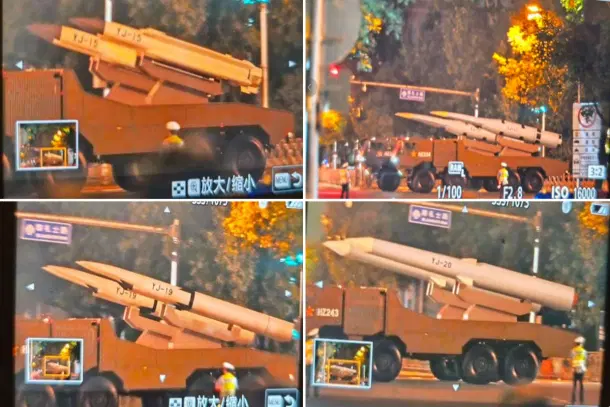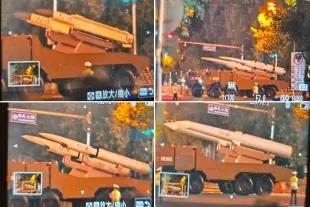News Brief
China’s Previously Unseen Hypersonic Missiles Revealed During Massive Parade Rehearsal
Swarajya Staff
Aug 20, 2025, 10:00 AM | Updated 10:00 AM IST
Save & read from anywhere!
Bookmark stories for easy access on any device or the Swarajya app.


China’s preparations for a massive military parade in Beijing on 3 September have revealed a suite of previously unseen missiles, highlighting the country’s rapidly advancing high-speed strike capabilities, according to TheWarZone.
The parade, marking the 80th anniversary of China’s victory over Japan in World War II, is shaping up to be one of the largest showcases of new weaponry in recent years.
Images circulating online from the ongoing rehearsals show trucks transporting multiple missile types, drawing particular attention to four models designated YJ-15, YJ-17, YJ-19, and YJ-20. Historically, the YJ designation has been associated with both anti-ship and land-attack cruise missiles that can be launched from aircraft, surface ships, submarines, or ground-based platforms.
The YJ-15 appears to feature a ramjet-powered design and bears a general resemblance to the YJ-12, a supersonic anti-ship missile with air, sea, and ground-launch options. The YJ-12 itself, developed by China Aerospace Science and Industry Corporation (CASIC), also has a land-attack capability in its export variant, the CM-302.
The YJ-17, in contrast, may be capable of hypersonic speeds exceeding Mach 5. Analysts suggest it could be a “waverider” missile that glides on shockwaves during flight, or possibly an unpowered boost-glide vehicle launched by a rocket before manoeuvring back to its target along a shallow atmospheric trajectory.
Its unique nose design has sparked debate over whether it is an air-breathing hypersonic cruise missile or a boost-glide system.
The YJ-19 displays a pronounced air intake, indicating a likely ramjet or scramjet propulsion system, positioning it as another high-speed, long-range option for the Chinese military.
Meanwhile, the YJ-20 appears to follow a more traditional multi-stage ballistic configuration, with similarities to a missile reportedly tested from a Type 055 destroyer in 2022. Some reports suggest this design could be compatible with future submarines or large surface vessels.
Together, these missiles signal a major leap in the People’s Liberation Army’s high-speed strike arsenal, particularly in the maritime domain.
Hypersonic and advanced supersonic weapons not only complicate defensive responses but also reduce the time required to engage time-sensitive targets, potentially giving China a strategic advantage in rapid strike scenarios.





